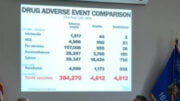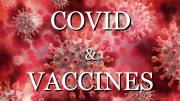By
In 2020 and 2021, Congress passed trillions in COVID-related stimulus funds, a good portion of which went to schools — but only if school officials aligned their policies with Centers for Disease Control and Prevention COVID guidelines.
n a January interview on Del Bigtree’s “The Highwire” —“COVID-19: Following the Money” — policy analyst A.J. DePriest, a member of the grassroots Tennessee Liberty Network, shared the group’s jaw-dropping findings about the undue influence of federal relief monies on school and hospital policies.
In this article, The Defender covers how federal money affected schools. We will cover the impact of federal money on hospitals in a separate article to follow.
In 2020 and 2021, Congress passed trillions in COVID-related stimulus through the Coronavirus Aid, Relief and Economic Security (CARES) Act, the Coronavirus Response and Relief Supplemental Appropriations (CRRSA) Act and the American Rescue Plan (ARP) Act.
Sizeable portions of those funds went to schools.
Digging into the education allotment, the Tennessee network discovered public, charter and nonprofit private schools in the U.S. received nearly $190.5 billion during three rounds of Elementary and Secondary School Emergency Relief (ESSER) funding (called ESSER I, II and III).
One of DePriest’s disquieting take-home messages is that this education lucre came with major strings attached — federal strings that are persuading ignominious school board members to adopt policies unfavorable and even dangerous to student health and well-being.
While DePriest characterized the stimulus bonanza as a “BIG carrot” for cash-strapped schools, that assessment may be too generous. If one examines the disturbing conditions attached to the U.S. Department of Education’s (DOE’s) dazzling largesse, the government billions seem closer to a godfather-like “offer they can’t refuse.”
The $190 billion ‘carrot’
The size of the federal “carrot” increased with each ESSER iteration. The $1.9 trillion ARP package alone assigned state educational agencies and school districts a whopping $122 billion (ESSER III).
On Jan. 18, the U.S. Department of Education (DOE) crowed about its disbursement of the final chunk of ESSER III monies, claiming the funds were “critical” for addressing “recent challenges” such as the putative and much-ballyhooed Omicron variant.
In Tennessee, the state’s initial take from ESSER I was nearly $260 million, but ESSER II quadrupled that amount to over $1.1 billion. By ESSER III, Tennessee’s educational haul had reached almost $2.5 billion.
The school district encompassing Memphis received roughly three-quarters of a billion dollars, DePriest noted, while Nashville schools pocketed a cool half a billion.
Schools and COVID vaccines
In DePriest’s view, there’s a catch that explains why school boards in every state have been so coldly unresponsive to parental pleas to unmask their children and abandon other COVID restrictions.
The catch is that federal generosity for state educational agencies is contingent on states proving to DOE (in reports submitted twice a year through fall 2023) they are meeting requirements synced with the Centers for Disease Control and Prevention’s (CDC’s) “safety recommendations.”
The CDC’s aggressive “recommendations” include:
- Enforcing “universal and correct wearing of masks”
- Physically modifying schools to facilitate “distancing”
- Ensuring “respiratory etiquette” and handwashing (likely with carcinogenic sanitizers)
- Implementing strenuous cleaning protocols to maintain “healthy facilities”
- Facilitating contact tracing, “in combination with isolation and quarantine”
- Conducting testing (both screening and diagnosis), helped along by additional resources from a federal-CDC-Rockefeller Foundation partnership to “ensure that all schools can access and set up screening testing programs as quickly as possible”
- Coordinating with state and local health officials
- Engaging in “efforts to provide vaccinations to school communities”
In its Jan. 18 press release, DOE took pains to emphasize that expanding access to vaccinations is “critical” for “safely reopening schools and sustaining safe operations.” And it furnished two ominous illustrations of how its stimulus monies are supporting vaccination efforts on the ground.
First, DOE noted, the Vermont Agency of Education is partnering with other statewide agencies “to vaccinate all Vermonters, including eligible students.” DOE approvingly stated that three-fourths of 12- to 17-year-olds in Vermont already received at least one dose.
DOE also considered the Hawaii Department of Education’s hosting of dozens of vaccination clinics for students, staff and “school communities” to be exemplary.
Further evidence of the feds’ hold over schools comes from the fact that some school districts have already taken steps to mandate COVID shots for some or all K-12 students, even in advance of formal U.S. Food and Drug Administration (FDA) approval.
Weaponizing HVAC systems?
More than 40% of school districts plan to spend some of their ESSER funds on “improvements” to heating, ventilation and air conditioning (HVAC) systems.
This raises a potential red flag in light of the Environmental Protection Agency’s (EPA) authorization in February 2021 — through a slippery “Public Health Emergency Exemption” — of a potentially hazardous, nanoparticle-based “air treatment” called Grignard Pure.
Dispersal of the chemical, authorized for indoor use in public spaces, occurs primarily “in-duct” via HVAC systems.
EPA’s authorization allows for Grignard Pure’s use in indoor spaces “when adherence to current public health guidelines … is impractical or difficult to maintain.”
As examples of spaces where the chemical’s use is permitted, the agency lists government facilities, healthcare facilities, food processing facilities and public transit.
EPA’s definition of “government facilities” does not appear to include schools, but the agency does admit to studying use of “air treatment technologies” on school buses.
A senior EPA scientist conceded last August, “how safe [the technologies] are, particularly for sensitive populations such as children, is not fully understood.” Given the experimental use of “air treatments” on school buses, it would behoove parents to query schools’ motives for upgrading their HVAC systems.
Moreover, though EPA initially green-lighted Grignard Pure in just two states (Georgia and Tennessee), it added four more states — Maryland, Nevada, Pennsylvania and Texas — last July.
The manufacturer’s website indicates that applications for Public Health Emergency Exemption are pending in another 15 states.
Nor does EPA’s vaguely worded list of indoor spaces seem to preclude use of the chemical in facilities not on that list. For example, Grignard Pure’s CEO is openly publicizing his product’s use in religious spaces, and a member of the company’s engineering steering committee elatedly stated last year, “There’s no limit to where we can use it!”
St. Simons Presbyterian Church in Georgia paved the way for church use, with the facility’s HVAC vents, which “run the length of both sides of the sanctuary’s ceiling,” apparently having been deemed ideal for spritzing congregants during services. This generates “a light haze [that] comes from the air vents and settles over the sanctuary.”
According to news accounts, the Georgia church’s pastor views Grignard Pure as “an added layer of safety,” a fact that the church emphasizes in its weekly bulletins. The pastor also is considering using the chemical-dispensing system during flu season.
Health risks associated with triethylene glycol
As The Defender previously reported, Grignard Pure’s supposedly virus-killing active ingredient is triethylene glycol (TEG), a chemical whose prior claim to fame was its use in theatrical fog machines.
Shortly before EPA reached its upbeat decision to approve TEG, the UK’s Scientific Advisory Group for Emergencies (SAGE) recommended against TEG’s use as a virucide due to its limited effectiveness and “potential health effects for those exposed over a long period of time.”
After WWII and in the early 1950s, there was an attempt to deploy TEG for “air disinfection” purposes in school settings. However, “wartime and post-war authors would not have had access to much of the toxicological and health data now available for this chemical,” said the UK SAGE group.
These data show “a number of potential acute health effects,” including respiratory tract irritation in case of inhalation.
A Berkeley, California lab — the Indoor Air Quality Scientific Findings Resource Bank — recently expressed multiple concerns about TEG in relation to air disinfection.
The indoor air quality experts cautioned, “careful attention should be given to dosage of triethylene glycol in indoor settings in order to minimize potential health effects caused by chemical exposure,” particularly in light of evidence of health effects with repeated exposure.
The Berkeley group also warned “TEG could react with other indoor chemicals” — including common disinfectants — “leading to additional and perhaps unexpected adverse health effects,” including toxic effects on human airway epithelial cells.
In light of these “uncertainties about TEG dosing, chemical mixtures, and health risks,” they suggested TEG should be viewed as a “lower priority” option.
In similar comments about the use of TEG “or other similar chemicals” for air disinfection (p. 23), SAGE wrote in November 2020:
“There is currently no strong evidence that using a continuous spray chemical in the air will be an effective control against SARS-CoV-2 transmission. …[T]here is no precedent for such an approach to be used as a continuous spray in an occupied space for infection control. Cleaning the air by spraying it with a chemical is a misnomer – it is simply swapping one contaminant for another.”
TEG’s cousin polyethylene glycol (PEG)
As The Defender reported a year ago, TEG is a chemical cousin to and sometime-component of polyethylene glycol (PEG), a synthetic, nondegradable polymer of questionable biocompatibility.
PEG is known to be associated with adverse immune responses, including anaphylaxis.
Both the Pfizer and Moderna COVID jabs use PEG to make their mRNA “carrier systems” work, and the compound is also present in numerous other drugs and consumer products.
Up to 72% of the U.S. population may have anti-PEG antibodies — including an estimated 8% with highly elevated levels — that could lead to life-threatening anaphylactic reactions. Research is needed to assess potential TEG-PEG cross-reactivity.
Children’s Health Defense (CHD) in August 2020 first sounded the alarm about the risks of PEG in COVID shots, pointing out that well before COVID, PEG had already been flagged, including by Moderna itself, for its potential to trigger immediate hypersensitivity reactions.
CHD was so concerned about the potential for anaphylaxis that it followed up with a letter to the FDA on Sept. 25, 2020, outlining the need for critical safeguards for Moderna clinical trial participants.
Those concerns have since been borne out by repeated reports of PEG-linked anaphylaxis that began surfacing concurrent with the two mRNA vaccines’ rollout.
Resistance is NOT futile
In mid-August, Tennessee’s governor issued an executive order giving parents ultimate decision-making authority over their children’s masking behavior at school.
U.S. Secretary of Education Miguel Cardona evinced no compunction about immediately chastising the governor and his education commissioner for taking matters into their own hands.
In a letter dated two days later, Cardona wrote that the Tennessee governor’s action was “at odds with the school district planning process embodied in the U.S. Department of Education’s. . . interim final requirements,” pointedly adding that CDC safety recommendations include “universal and correct wearing of masks.”
Meanwhile, Treasury Secretary Janet Yellen warned Arizona Gov. Doug Ducey on Jan. 14 that the Biden administration is prepared to take back Arizona’s relief funds — and also withhold future federal aid — due to the state’s active discouragement of school mask mandates.
Yellen offered no explanation as to why the Treasury Department, rather than DOE, was issuing the warning.
In response, Ducey emphasized Arizona’s focus on “things that matter” — math, not masks. Attorney General Mark Brnovich urged Yellen to rescind the threat, arguing that Treasury is “trying to overstep its constitutional bounds” by dictating how the state should run and fund its schools.
These types of intimidation tactics are also evident at the school-district level, prompting parents’ growing frustration.
Rather than continue to beg for mask lenience, DePriest reminds parents they have every right to confront school board members about the feds’ cash-in-exchange-for-obedience arrangements.
“They’re getting the money to mask your kids. It has nothing to do with health and safety,” DePriest said.
As evidenced by the quadrupling of homeschooling since the beginning of COVID, many families have simply had it. However, for parents for whom homeschooling is not an option, there is every reason to push local school boards to address their student-unfriendly behavior more transparently.
Here are a handful of possible questions and actions:
- Borrowing DePriest’s no-nonsense wording, a first step is to ask, “How much money are you taking from the federal government to commit this egregious, tyrannical behavior on our kids?” If school board members profess not to know, prepared citizens can easily present them with the financial information listed here.
- As one state describes it, “The governance of local school boards by democratically-elected individuals remains at the heart of two vital United States structures: the public education system and democracy itself.” Remind school board members that when they put politics and financial arm-twisting ahead of their relationship with the public and the students they are supposed to serve, they are engaging in a fundamental betrayal of trust and ethics.
- Emphasize to school board members that the damage caused by COVID restrictions has far outweighed any threat from the illness, turning schools into “a physically, spiritually, and emotionally unsafe place” for children. Moreover, none of the restrictions are genuinely evidence-based.
- Continue to present school board members with evidence about the experimental COVID injections’ dangers (see sample talking points here).
- Ask schools whether they are planning for or engaging in HVAC “improvements.” If yes, ask them to describe the purpose of the “improvements” and whether schools intend to use HVAC systems to disseminate unsafe chemicals. Tell them EPA is doing research on “air treatments” in school buses, and let them know about the risks — both known and hypothesized — of chemicals like TEG.
- Finally, for officials who claim that their hands are tied, A.J. DePriest has a ready solution: Tell them to “give the money back”!
“©01/20/22 Children’s Health Defense, Inc. This work is reproduced and distributed with the permission of Children’s Health Defense, Inc. Want to learn more from Children’s Health Defense? Sign up for free news and updates from Robert F. Kennedy, Jr. and the Children’s Health Defense. Your donation will help to support us in our efforts.





